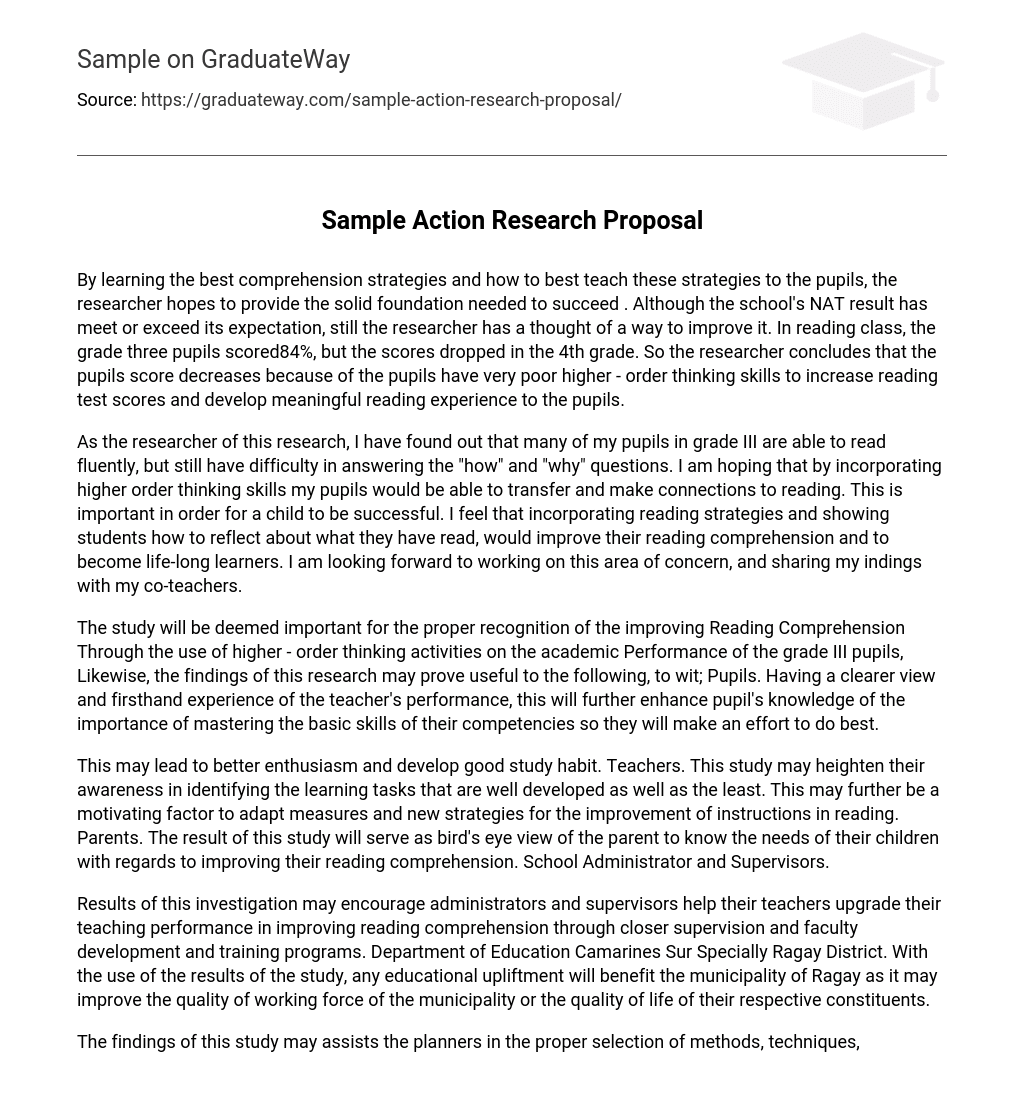By learning the most effective strategies for comprehension and how to teach them to students, the researcher aims to provide a strong foundation for success. Despite the school’s NAT result meeting or exceeding expectations, the researcher believes there is room for improvement. In the reading class, third-grade pupils scored 84%, but scores dropped in the fourth grade. As a result, the researcher concludes that the decrease in scores can be attributed to poor higher-order thinking skills among the students, which hinders their ability to improve reading test scores and engage in meaningful reading experiences.
As the researcher of this study, I have discovered that many of my grade III students can read fluently but struggle with answering “how” and “why” questions. I hope that by integrating higher order thinking skills, my students will be able to apply their knowledge and make connections to their reading. This is crucial for their future success. I believe that teaching reading strategies and encouraging students to reflect on their reading will enhance their comprehension and promote a lifelong love for learning. I am excited to delve into this area of concern and share my findings with my colleagues.
The importance of the study lies in recognizing the positive impact of higher-order thinking activities on the academic performance of grade III pupils in improving their reading comprehension. Additionally, the findings of this research will be valuable to various stakeholders, particularly pupils. By gaining a better understanding and firsthand experience of their teacher’s performance, pupils will be motivated to prioritize mastering the fundamental skills necessary for their competencies, leading them to strive for excellence.
The study has potential benefits for various stakeholders. For teachers, it may increase their understanding of the effectiveness of different learning tasks and inspire them to implement new strategies for improving reading instruction. Parents can gain insight into their children’s needs for enhancing reading comprehension through the findings. School administrators and supervisors will obtain a comprehensive view of the study and its potential impact on the school system.
Administrators and supervisors should utilize the investigation’s findings to assist teachers in enhancing reading comprehension. This can be accomplished through increased supervision and participation in faculty development and training programs provided by the Department of Education Camarines Sur, specifically within the Ragay District. The study’s results have the potential to contribute to the educational advancement of Ragay Municipality, resulting in an improved quality of life for its constituents.
The findings of this study can assist planners in selecting the suitable methods, techniques, and strategies to reinforce within the community. Moreover, these results can benefit the community by guaranteeing that teachers possess the essential tools and competence to efficiently educate their children. Furthermore, this study can inspire researchers to surpass their own capabilities in teaching and offer guidance for future researchers aiming to delve deeper into this subject.
The aim of this study is to offer guidance and inspiration for other researchers in constructing their conceptual framework and design. It also aims to motivate them to carry out similar studies in their own areas of interest. The main focus of this study is on enhancing reading comprehension among third-grade students by utilizing higher-order thinking skills activities. The study investigates different reading strategies, such as predicting, making connections, visualizing, inferring, questioning, and summarizing, which have been proven effective in improving reading comprehension.
This study utilizes the pre-Experimental one shot case study method, as described by De Jesus. In this design, a single group is studied only once after receiving instruction in reading strategies. It is important to teach these strategies through various methods, including naming the strategy and explaining how it should be used, modeling through think aloud processes, practicing in groups and with partners, and independently using the strategy. Another tool employed in this study is the Phil-Iri test, which was administered to grade III pupils in the first week of July 2011. This test is used to assess student growth in reading comprehension. The researcher also used a teacher observation checklist to collect data throughout the intervention.
This tool gives information about changes in the understanding and use of reading comprehension strategies by pupils over time. Purposive sampling was used to select pupils as respondents for the study. The selected pupils were enrolled in the third grade class for the school year 2011-2012. The Metacomprehension Strategy Index included a total of 25 questions divided into three parts, which inquired about the strategies used by pupils to enhance their understanding of the story.





